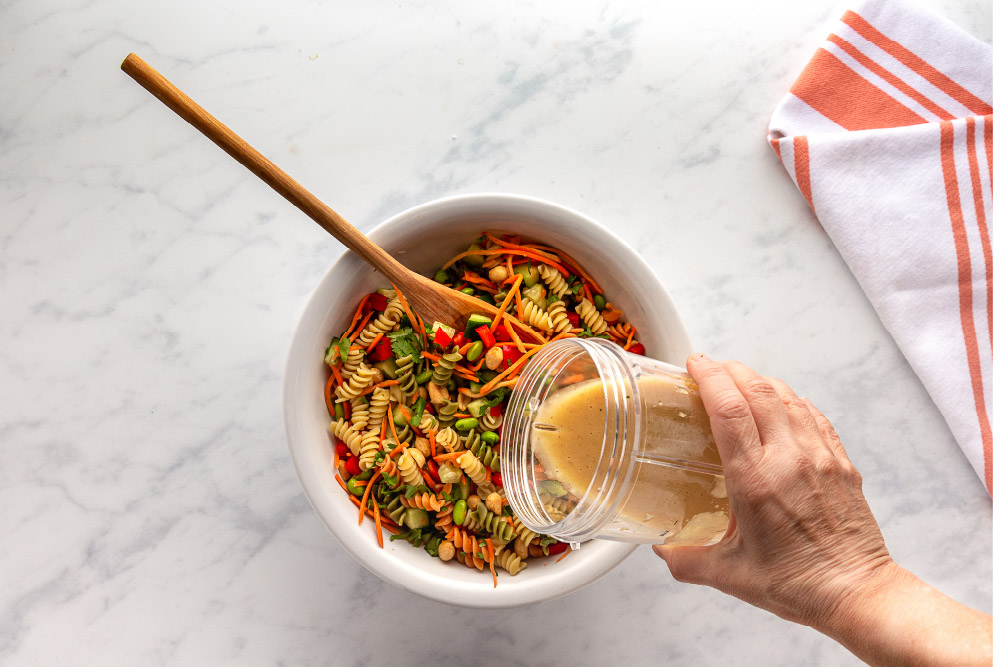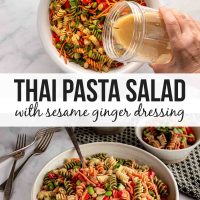Bursting with color and flavor, Thai Pasta Salad with Sesame Ginger Dressing is a perfect side dish. Carrots, red bell pepper, and edamame mixed with spiral pasta and peanuts are drenched in a delicious ginger dressing in this easy, impressive Thai peanut pasta salad.

Video
What you need to make this Thai Pasta Salad recipe

Sesame Ginger Dressing
- vegetable oil
- rice wine vinegar
- tamari or soy sauce
- Dijon mustard
- freshly grated ginger
- honey
- toasted sesame oil
- sriracha hot sauce
Thai Pasta Salad
- diced cucumber
- diced red bell pepper
- shredded carrots
- whole cocktail peanuts
- finely chopped fresh cilantro leaves
- steamed and shelled edamame
- tri-color rotini
How to make Thai Pasta Salad
Dressing
Thai Pasta Salad is mixed with Sesame Ginger Dressing, which can be made ahead and stored in the refrigerator in an airtight container for up to 4 days.
Combine all of the dressing ingredients in the immersion blender container (if you do not have an immersion blender, you may use a regular blender). I do not recommend using a whisk to mix the dressing as it will be difficult to get it to the point of emulsifying.

Blend for 1-2 minutes until the mixture has emulsified into a smooth consistency.
Salad
Cook pasta according to the package directions.

While the rotini is cooking, combine the prepared vegetables, peanuts, cilantro, and edamame in a large bowl with lid.

When the rotini is done, drain and rinse with cold water until the pasta is cool to the touch, then drain pasta well.
Add the pasta to the vegetables in the bowl. Toss gently.

Pour the dressing over the pasta and vegetables and mix well.

Refrigerate for 1-2 hours or until ready to serve. If preparing more than two hours in advance, refrigerate salad and dressing separately in airtight containers, and add dressing to salad 1-2 hours before serving.
FAQ
Edamame (pronounced ed-uh-mah-mey) are young soybeans in the pod. They are lightly steamed or boiled in salt water before serving. Edamame are served either in the pod as a snack to be popped in the mouth directly from the pod, or shelled and added to recipes.
In Japan, salted edamame are often served on salad bars or as finger food at bars the way American bars might serve pretzels.
In Thai Pasta Salad, they are are steamed, rinsed, and drained before adding to the pasta salad.
Tamari is a Japanese soy sauce that is derived from miso paste. It is made with little to no wheat (San-J brand is gluten-free), and it has a richer flavor that taste less salty than soy sauce.
Tamari is generally more expensive than soy sauce and is harder to find in a store brand. I always use tamari when adding to sauces and dressings, but for recipes such as marinades where larger quantities are required, I use soy sauce.
Ginger root is sold in the produce section of grocery stores. To use it in recipes, it should be peeled with a vegetable peeler to reveal the fresh, moist root under the dry skin. I generally peel about two inches of the root and use the unpeeled portion to hold while I grate it.
To grate, use the small section of a standing grater or for better results, a microplane grater. Push the peeled part of the root across the grating plane over a dish to catch the grated ginger. Periodically scrape the excess ginger clinging to the back side of the grater into the dish to clear the holes.
Thai Pasta Salad is perfect for making in advance, but if making more than two hours before serving, each ingredient group (cooked pasta, prepared veggies, peanuts, and dressing) should be stored separately in the refrigerator and tossed together 1-2 hours before serving.
Thai Pasta Salad with Sesame Ginger Dressing is only very slightly spicy, but if you would like to add some more kick to the salad, you could increase the amount of sriracha or add crushed red pepper flakes, chili paste, or chili oil.
Absolutely. You could substitute any other pasta shape, or even switch to soba noodles or rice noodles.
Switching to soba noodles or rice noodles makes this recipe gluten-free as long as gluten-free tamari or soy sauce is used. The other ingredients are generally safe, but if they contain gluten it should be labeled as such.
If you want to avoid peanuts, you can substitute cashews or simply omit the peanuts from Thai Pasta Salad.
Although I prefer this pasta salad without onion, if I were to add it, I would use either chopped red onion or green onion.
Recipe

Thai Pasta Salad with Sesame Ginger Dressing
Equipment
Ingredients
Sesame Ginger Dressing
- ¾ cup vegetable oil
- 4½ tablespoons rice wine vinegar
- 2¼ tablespoons tamari or soy sauce
- 1½ tablespoons Dijon mustard
- 1 to 3 tablespoons fresh ginger, grated
- 3¾ tablespoons honey
- ⅓ teaspoon toasted sesame oil
- ⅓ teaspoon sriracha hot sauce
Thai Pasta Salad
- 1 cup cucumber, diced
- 1 cup red bell pepper, diced
- ⅔ cup shredded carrots
- 1⅓ cups whole cocktail peanuts
- 2 tablespoons fresh cilantro, finely chopped
- 1½ cups edamame, steamed and shelled
- 16 ounces tri-color rotini
Instructions
For the sesame ginger dressing
- The dressing can be made ahead and stored in an airtight container for up to 4 days.
- Grate 1 to 3 tablespoons fresh ginger(to taste; I like more than most people).
- Combine ¾ cup vegetable oil, 4½ tablespoons rice wine vinegar, 2¼ tablespoons tamari or soy sauce, 1½ tablespoons Dijon mustard, grated ginger, 3¾ tablespoons honey, ⅓ teaspoon toasted sesame oil, and ⅓ teaspoon sriracha hot sauce in the immersion blender container (if you do not have an immersion blender, you may use a regular blender). I do not recommend using a whisk to mix the dressing as it will be difficult to get it to the point of emulsifying.
- Blend for 1-2 minutes until the mixture has emulsified into a smooth consistency.
For the Thai pasta salad
- Cook 16 ounces tri-color rotini according to the package directions.
- Steam and shell 1½ cups edamame. Cool.
- Dice 1 cup cucumber 1 cup red bell pepper. Finely chop 2 tablespoons fresh cilantro.
- Combine cucumber, red bell pepper, ⅔ cup shredded carrots, 1⅓ cups whole cocktail peanuts, cilantro, and edamame in a large bowl with lid.
- When the rotini is done, drain in a strainer or colander and rinse with cold water until the pasta is cool to the touch.
- Drain pasta well and add to the vegetables in the bowl. Toss gently.
- Pour the dressing over the pasta and vegetables and mix well.
- For best results, refrigerate for 1-2 hours or until ready to serve. If preparing more than two hours in advance, wait to add dressing to salad until 1-2 hours before serving.







Leave a Reply